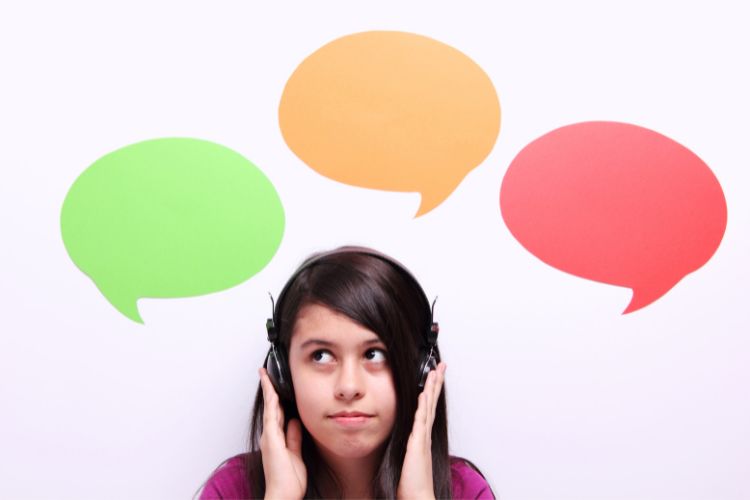As you get your feet wet learning a new language, you’ll see that there are four areas of learning: reading, writing, listening, and speaking.
Your goals will direct your initial focus, but you can’t go too far without all four. Just like you can’t go too far in the gym without doing some cardio, some stretching, and some strengthening.
As you would at the gym, you’ll be drawn to some elements of language learning more than others.
If a language course doesn’t provide adequate input through reading and listening at an appropriate level, the learner will miss out on crucial learning opportunities.
According to research on young foreign language learners, increasing the amount of interesting and understandable written input without increasing class time resulted in nearly double the language proficiency gains compared to a program with the same amount of class time but less input.
Similarly, if learners don’t use bilingual flashcards and instead do passive-vocabulary-related exercises, they will likely learn vocabulary at a rate that is less than half of what they could otherwise achieve.
If the chosen course doesn’t include fluency development activities such as timed reading, then taking a timed reading course will increase reading speed by at least 50%, if not more.
Balance the 4 Areas of Learning to Meet Specific Goals
Balanced learning is the most important criterion. Guided Immersion’s Five Factor Framework is designed to promote a balanced language course.
Ideally, a learner should spend equal time on comprehensible input, grammatically correct output, meaningful interactions, formal instruction (study), and practice and repetition. We’ll look at each of those later.

Based on their objectives, each learner can adjust the balance of these elements.
If the language they’re learning has a sound system that is very different from that of their native language, it’s worthwhile for the student to deliberately learn about the sound system.
It’s important to find a teacher who can explain how the sounds are produced in the mouth, rather than just saying sounds to copy.
Alternatively, the learner can conduct that research on their own. Some people can learn the sounds without any help or study, but if they’re having difficulty, it’s best to seek out a teacher.
If the learner’s only goal is to read the language, they can redirect the time spent on verbal output into more reading input. Similarly, if their goal is simply to speak the language (especially if the script is difficult), they may want to make all of their input spoken language.
Finding the Right Balance

You’ll find the right balance of these four elements for yourself. True comfort in a language requires command of the four domains of language learning: reading, writing, speaking, and listening.
While it’s not necessary for every learner to be equally strong in all four domains, they should avoid the temptation to neglect a domain entirely.
Guided Immersion’s Five Factor Framework and the associated activities were designed to provide a broad range of options that empower the learner to take control of their language learning journey.
The Balance Between Listening and Reading (Input)
Listening to the way the language is spoken, even if you don’t understand the words, is useful in the early stages of learning a language. A good way to do this is to watch a movie with subtitles in that language.
This type of form-focused listening gives students a feel for the language, which will be helpful when they begin speaking it on their own.

As language skills improve, a good way to get some listening practice is to find a movie with a downloadable script and study it before watching the film.
The first step is to read the script, look up unfamiliar words, and figure out what the sentences mean. They can then watch the movie with subtitles again a few weeks later.
Similarly, many graded readers now come with an accompanying audio file that provides the spoken version of the text. Try both reading before listening and reading while listening.
The Balance Between Speaking and Writing (Output)
While listening and reading are referred to as “receptive skills” because they involve the receipt of input, speaking and writing are referred to as “productive skills” because they result in the creation of output.

In general, producing language is more difficult than receiving it because the speaker must make decisions about word choice and grammatical constructions when generating language.
Over one-quarter of the time in a balanced language learning program should be devoted to productive skill development, which includes gaining fluency in speaking and writing, according to the criteria of Guided Immersion, which we follow in this course.
Give Yourself Adequate Time and Balance for Language Learning
Regardless of how much they focus on each skill, language learners should spend as much time as they reasonably can engaging in their target language.
Language learning is a process, not an event with an end goal. Additionally, language learning should be enjoyable, and a balanced journey will include equal effort across each of Guided Immersion’s Five Factor Framework.
Let’s delve into each of the four areas and how you can use them to further your goals.
Reading: How Can One Learn a Language Through Reading?

Research has demonstrated that one can learn a lot of a language through reading. To improve their language skills through reading, the learner should read texts at a suitable level. This is simple if the learner speaks English, but impossible for learners of many other languages.
This is because there are many courses in English called graded readers that are specially written with a controlled vocabulary for English learners.
Graded readers are courses designed specifically for foreign language learners, allowing them to read courses at the appropriate level at almost any level of proficiency.
Learners can visit the Extensive Reading Foundation for more information on graded readers, as well as to see which ones have been voted the best. There are a few graded readers in Japanese and French.
If a person is learning a language other than English, it’s beneficial to obtain the courses that native speakers use in school when they learn to read.
This is because these courses are designed for students with limited vocabularies and don’t introduce words that these first-language students are unlikely to know.
Encyclopedias, particularly those written for young children, are another good source of reading.
Reading promotes language learning through repetition.
That is, as they read, students come across words, word groups, and grammatical constructions. Students have a good chance of learning these patterns because they appear several times in a text.
Additionally, reading can be enjoyable and create feelings of success, which encourage students to continue learning.
Is it a good idea for a learner to pick an interesting course and read it from beginning to end, learning all the new words they encounter? If the course isn’t written in a controlled vocabulary or isn’t on a topic about which the learner is already well-versed, probably not.

The main reason for this is that it will contain a large number of unknown words (possibly more than 1000), the majority of which will be well outside the learner’s current vocabulary. Approximately half of all words in a text appear only once.
However, it is worth struggling through a text if one or more of the following conditions apply:
- The text is a set requirement for a course.
- The course is an important text in the learner’s academic field, and it will help them learn the technical vocabulary of this field.
- The subject matter of the course is familiar to the learner, and the technical terms are similar to those in their L1.
- It’s a novel that they have already read in their first language, so they can easily guess or skip many of the unknown words.
Purchasing an electronic version of the text or scanning it to create an electronic version can be beneficial. (Don’t distribute the electronic version, as this will break the copyright.)
Dictionary access comes with using an electronic reader such as a Kindle. Narrow reading of various short texts on the same topic is a valuable alternative to reading a long text.
Is it better to re-read the same course or read a different one?
The advantages of re-reading a course are:
- It’ll be a lot easier than reading it the first time.
- It’ll guarantee the repetition of the vocabulary.
- It’ll provide an opportunity for recall of previously met vocabulary.
- It may help develop reading fluency.
- It’ll take much less time than reading a different course of the same length.
The advantages of reading a new course are:
- Some of the words met in the previous course will be met again in different contexts.
- There’ll be many new words to learn.
These lists suggest that re-reading is a good idea and that a language learning program should include a mix of re-reading and new reading.
The goal in the early stages of language learning should be to spend at least 30 minutes to an hour per week doing meaningful listening and reading. Learners should extend this time as their proficiency grows.
Writing: How Can One Learn a Language Through Writing?

There should be three kinds of writing in any language course. The first kind of writing is done carefully, with the help of a dictionary when necessary, focusing on accuracy.
Someone proficient in the language should correct the learner’s writing so that they can get feedback on its accuracy.
The second kind of writing should focus on fluency. The most useful activity for doing this is writing.
The third kind of writing focuses on the quantity of writing under careful conditions and doesn’t require feedback on the language, although it’s always useful.
According to the time-on-task criterion, the more time an individual spends on an activity, the better they will be at it. Regular practice improves all four skills (listening, speaking, reading, and writing).
Speaking: How Can One Learn a Language Through Speaking?

Memorizing useful phrases and sentences is the quickest way to start speaking another language. The first phrases and sentences should include:
- Greetings
- Polite expressions
- Language for communicating
- Numbers
- Brief descriptions of oneself, one’s work, and reasons for being in a foreign country
As proficiency grows, it’s beneficial to form a group (hopefully including a native speaker or two) that meets regularly to practice conversation.
Learners can roleplay through a list of situations in which they’re likely to find themselves during these conversation sessions. They should practice each scenario two or three times in a session, followed by once or twice in increasingly spaced subsequent sessions.
A native speaker is unlikely to correct a foreign language learner in a normal conversation if their language is understandable but incorrect. As a result, locating someone capable of and willing to provide corrective feedback is particularly beneficial.
It’s also beneficial to choose a specific focus for correction, such as the pronunciation of a sound or the use of a grammatical feature, so that the corrections aren’t overwhelming and spread across multiple areas of language development.
Because of the lack of interaction with others when studying alone, speaking is the most difficult skill to develop. Learners must seek out these opportunities, including direct contact with native speakers, other learners, and electronic contact.
Listening: How Can One Learn a Language Through Listening?

Movies are typically under 10,000 words long (a novel is usually over 100,000 words long) and contain around 1,000 different word families. These words have a variety of frequency levels.
A learner must have a reasonably large vocabulary to follow most of the words in a movie without any preparation — at least 3,000 words, but preferably around 6,000.
Preparing for a movie by reading the script and studying the vocabulary is manageable because the number of different words in a movie isn’t so large.
Because the amount of meaningful input has a strong influence on language learning, the learner should strive to get plenty of listening and reading input at an appropriate level of difficulty on a regular basis.







